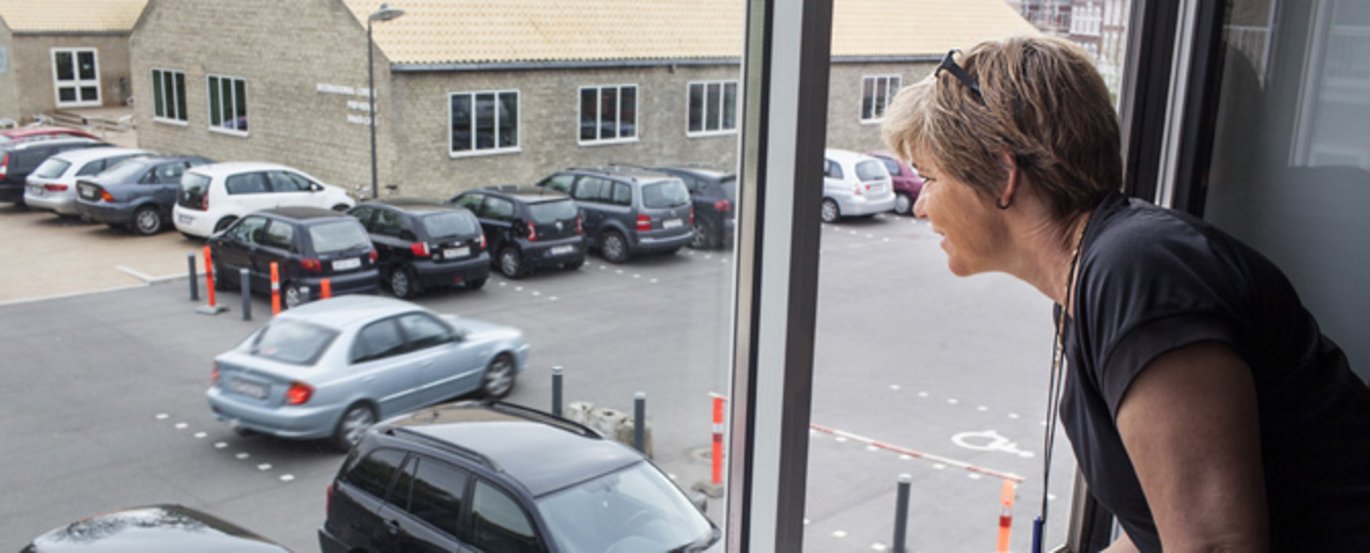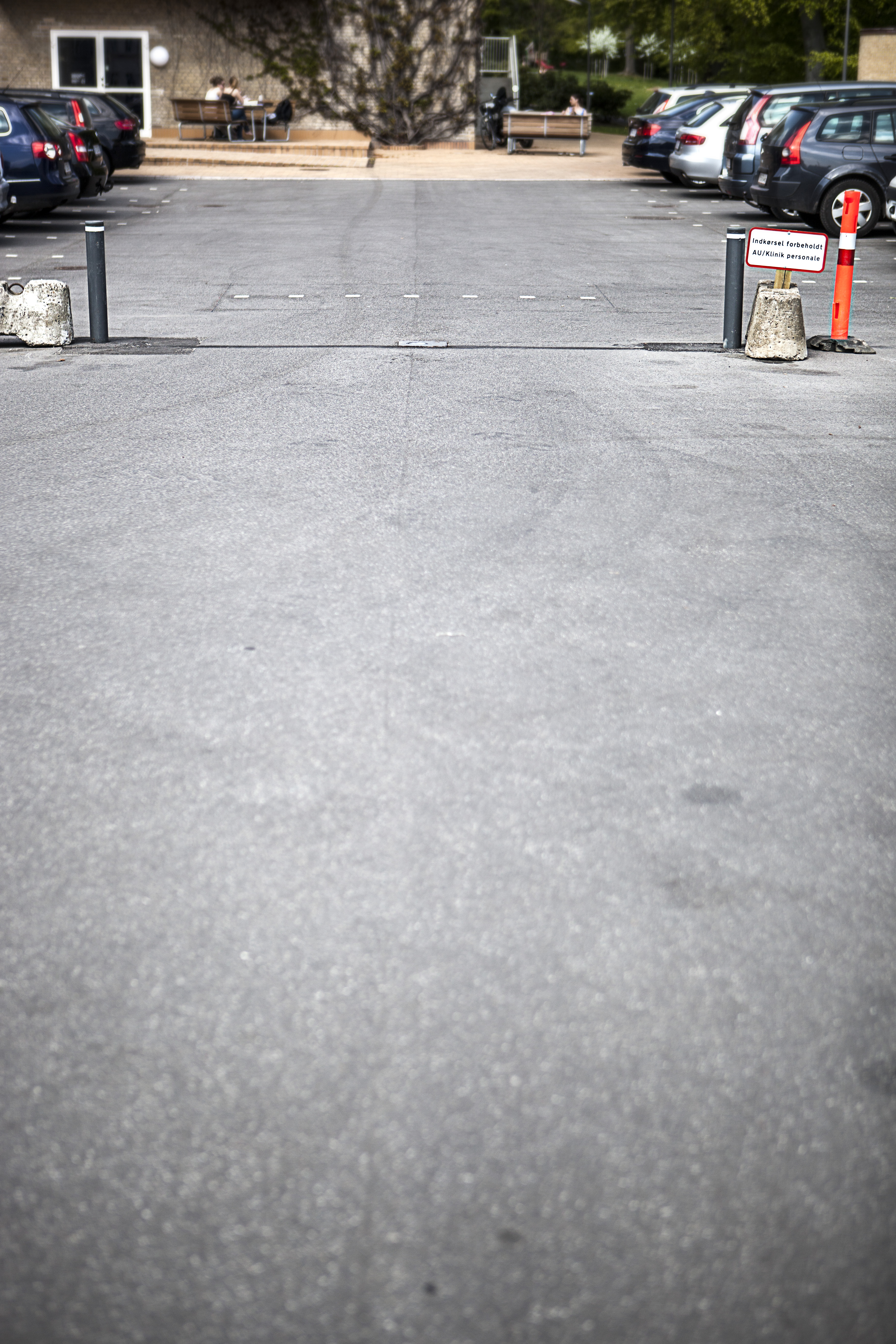Keeping up appearances...
For the new car park in front of AIAS, aesthetics took pride of place. But the facility has cost dents, scratches and furrowed brows. After a number of technical improvements, the facility was allegedly in working order. But it’s been been taken out of operation anyway because motorists need to learn how to use it first.



Department Secretary Helle Nielsen looks out of her office window at the Section for Nursing. But she is not admiring Vennelyst park and its green lawns. What she is looking at is the car park just below her that fills the square between AIAS (Aarhus Institute of Advanced Studies) and the Section for Nursing. For months she has witnessed her colleagues’ cars collide with the car park’s bollards and pillars . And she’s watched the car park be taken out of operation again and again. And she’s also witnessed the supplier and AU’s technical staff hold innumerable meetings beside the bollards and pillars. She is a bit puzzled:
"How difficult can it be to build a car park? More than ten months and it still doesn’t work properly - how can that happen?"
An aesthetic solution
In several locations, AU makes use of red and white barriers to reserve car parking spaces for the university's staff and guests. But for AU's relatively newly established prestige project AIAS, AU Planning and C. F. Møller Architects agreed on a more aesthetic solution. The car park is enclosed by dark grey metal pillars. and instead of a red and white barrier, the entrance is blocked by a bollard that disappears into the ground when a car that has the right to use the car park drives through.
"We have tried to raise the architectural level around AIAS and a bollard is much less intrusive than a barrier. In general, we also have to be cautious with the installations we introduce in the University Park, because we risk the area becoming a listed area if the solutions we choose disfigure the park," explains the acting head at AU Planning, Berit Kornbæk.
A technical challenge
However, it has required a number of adjustments to make the car park fully operational. The dark grey pillars were difficult for drivers to see in the darkness of winter, so they were fitted with thin reflective bands and lights at the entrance. The sensor in the asphalt that registers when a car is on the way out of the car park was not strong enough and had to be replaced by the supplier. The car park system had to be programmed so it could communicate with two different security systems. Finally, the bollards were programmed to be lowered for a specific number of seconds, after which they rose again. This has been changed so that they now remain down for as long as the sensors register that a car is travelling over the bollard.
Almost…but not quite
During the past few months a number of Department Secretary Helle Nielsen's colleagues have had run-ins with the car parking system. One of them is Annesofie Lunde Jensen, a PhD student at the Department of Public Health.
"I drove right into them one night. I was being very careful to make sure I didn’t run into any of the pillars. They’re the same height as the car and dark grey, so they’re hard to see in the dark, and this was before they added reflective tape. I just managed to think "Phew, made it!”, but then I suddenly heard the pillar scratch one side of the car."
Annesofie Lunde Jensen did not, however, report the damage to her insurance company, as she has an older car.
"But it’s annoying because I was really concentrating on avoiding them."
Ruined the undercarriage
Things were worse for cleaning assistant Inge Nielsen one morning in April. She was already uncomfortable about using the car park as a number of her colleagues had gotten their cars damaged there.
"But there weren’t any vacant spaces outside the car park so I had to try and park there. And the experts had also said that everything should work."
At the car park exit, Inge Nielsen drove forwards towards the bollard, as the light was green and the bollard was lowered. But before she managed to drive over the recessed bollard, it rose up again beneath the front of her car, damaging its undercarriage. Damage that cost DKK 55,000 to repair - and it’s not yet clear who is responsible for paying for the repairs.
"It’s terrible. I live in Ajstrup outside Aarhus and have to be at work at five o’clock in the morning and the buses don’t run that early. So I really depend on my car."
Material damage is one thing…
From the reception at the Vennelyst park doctor’s surgery, nurse Helle Fallesen has also had a front row seat to follow the car park system’s difficulties.
"An ambulance collided with one of the pillars because the ambulance driver simply couldn’t see the pillar. It was then unable to drive so we had to call a new ambulance. Luckily it wasn’t so critical that the patient’s life was endangered."
The incident makes her fear the worst:
"What worries me most is what will happen if we have to call an ambulance for a patient who needs to be rushed to the hospital with a life-threatening condition. The ambulance has to drive through the car park to get to an entrance that is wide enough to get a stretcher through. But imagine what will happen if the pillar won’t go down or if it goes back up under the ambulance and it can’t drive any further. So it could ultimately cost lives."
Bad system or bad drivers?
Department Secretary Helle Nielsen is one of the members of staff who have, on several occasions, personally drawn AU's technical staff attention to the problems with the system.
"I know of at least 12 cars that have been damaged by the car parking system in one way or another, which suggests that the problem lies with the system and its layout rather than the driving."
She also has another concern:
"Who’s paying for all this? For all the changes and repairs and working hours spent on the parking system, and for the damage done to people's cars? Are my taxes paying for all of that? Is AU paying for it? At a time when we have said goodbye to hundreds of employees?"
Only know of four cases
Berit Kornbæk from AU Planning has not heard about the ambulance being damaged and only knows of four drivers who have had accidents in the car park.
"We’ve only been contacted in connection with four cases. In two of the cases liability for damage has been placed with the supplier of the system. In the other two cases, the liability for damages has been rejected, as the drivers involved have operated the system incorrectly."
She also tells us that the majority of the expenses related to the technical adjustments have been met by the contractor.
That’s the way to do it
The car park and its system should now work without problems. Nonetheless, it has still been temporarily taken out of operation, as AU Planning have prepared a detailed user manual for the parking system which is being sent to motorists who use the car park.
"As several of the cases have been about drivers using the system incorrectly, we have decided to take the system out of operation while we provide more information about using the system, because we really don’t want any more of these cases," says Berit Kornbæk.
Annoying case
Conor Leerhøy, who is head of building services at Health, has been closely following the parking system lately. Once the supplier has fixed the system’s final problems and defects he will be responsible for the day-to-day operation of the system. And with the many problems over the past months, it is a task he is approaching with a certain amount of vigilance.
"I think it's been annoying. And I can certainly understand the employees' frustration. But the car parking system works now, and before I take over responsibility for its operation I’ll conduct a thorough test together with my staff – just to be on the safe side. Should there be problems with the car park after this, then I’m the person you should get in touch with."
Translated by Peter Lambourne

